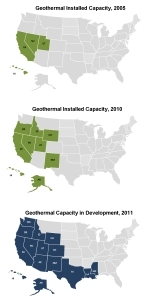Geothermal Energy Association Yearly Update: Industry Poised for Ascendant Growth, Continuing Regional Expansion
 |
WASHINGTON--March 31, 2011: With new developments and pioneering technology, geothermal energy is spreading throughout the United States, as described in the yearly update on the geothermal industry from the Geothermal Energy Association (GEA). The Annual GEA U.S. Geothermal Power Production and Development Report shows that in 2011, the geothermal industry is producing clean power in nine states and developing 146 projects across 15 states, with the total number of geothermal projects and prospects under development increasing 12 percent.
“By providing the industry and public with a lexicon of definitions and a guideline to determine phases of development, we can better asses a geothermal project's position in the development timeline.”
The United States ranks No. 1 in geothermal energy production and continues to be one of the leading countries in geothermal growth. The total installed capacity of the U.S. is approximately 3,102 MW, enough to power over 2 million homes -- or the residential populations of San Francisco, Portland and Seattle combined. Currently, geothermal electric power generation is occurring in nine U.S. states, including: Alaska, California, Hawaii, Idaho, Nevada, New Mexico, Oregon, Utah and Wyoming. Bringing the geothermal resource capacity GEA identifies on-line would triple U.S. geothermal power production.
"The geothermal industry has an exciting year ahead, as there are numerous projects switching from development phases to full-fledged geothermal power plants," said GEA Executive Director Karl Gawell. "And a second wave of development is on its way. This report reveals that many projects are entering the drilling and production phase, which is where the majority of geothermal job creation is."
As the majority of the industry remains concentrated in the western U.S., pilot projects are beginning to show development potential further east. New projects are focusing on generating geothermal electricity from low temperature fluids left over as a byproduct from oil and gas production and harnessing electricity from geothermal fluids under high geological pressure along the Gulf of Mexico.
"We are building new plants in places that have never had geothermal power before, giving people in these states the clean and renewable power we need," said Gawell.
Many projects currently undergoing advanced stages of production are located in Nevada and California, with additional projects nearing construction in Oregon, New Mexico, Idaho, and Hawaii, Alaska, Louisiana and Mississippi.
"While the government incentive programs may have given the geothermal space a lift in terms of initiating new activity, it's going to take additional support from Private Investment that will fuel the majority of the growth in years to come," said Saf Dhillon, Investor Relations, U.S. Geothermal Inc.
While the number of states with geothermal installed capacity and projects in development is significant, the reach of the geothermal industry is even more extensive. A total of 43 states have companies involved in geothermal development operations.
"Atlas Copco's involvement in the geothermal industry has grown steadily over the past three decades. All three of our divisions (Industrial Technique, Compressor Technique and Construction and Mining Technique) provide machines and tools for geothermal development and power generation. From geothermal well exploration, to the Hurricane® power booster, and finally the binary cycle tureboexpander generators, Atlas Copco plays a key role in providing clean geothermal energy to the nation's power grid," commented Behrooz Ershaghi, Manager of Technology for Atlas Copco Mafi-Trench Company LLC.
For the first time, the Annual GEA U.S. Geothermal Power Production and Development Report was produced under a reporting system known as the Geothermal Reporting Terms and Definitions in order to increase the accuracy and value of the information presented. The Geothermal Reporting Terms and Definitions act as a guideline to project developers in reporting geothermal project development information to the GEA.
"The new system increases the precision of our reports," said GEA Research Associate Dan Jennejohn. "By providing the industry and public with a lexicon of definitions and a guideline to determine phases of development, we can better asses a geothermal project's position in the development timeline."
Geothermal leaders will gather in Washington DC on Wednesday, May 4 for the Geothermal Energy Association (GEA) 2011 Geothermal Energy Technology and International Development Forum. The event, developed in conjunction with the U.S. Department of Energy and the U.S. Department of Commerce, will be held at The Ronald Reagan Building and International Trade Center. For more information about the event, please visit Geo Energy Showcase.
The full report can be accessed at Geo Energy.
GEA and industry leaders will participate in press tele-conference on Wed., March 30 at 12:00pm EDT. For more information, please contact Garret Drexler at garret@rosengrouppr.com or 646-695-7042.
About the Geothermal Energy Association:
The Geothermal Energy Association (GEA) is a trade association composed of U.S. companies who support the expanded use of geothermal energy and are developing geothermal resources worldwide for electrical power generation and direct-heat uses. GEA advocates for public policies that will promote the development and utilization of geothermal resources, provides a forum for the industry to discuss issues and problems, encourages research and development to improve geothermal technologies, presents industry views to governmental organizations, provides assistance for the export of geothermal goods and services, compiles statistical data about the geothermal industry, and conducts education and outreach projects.
For more information, please visit http://www.geo-energy.org/. Follow GEA on Twitter. Become a fan on Facebook.


